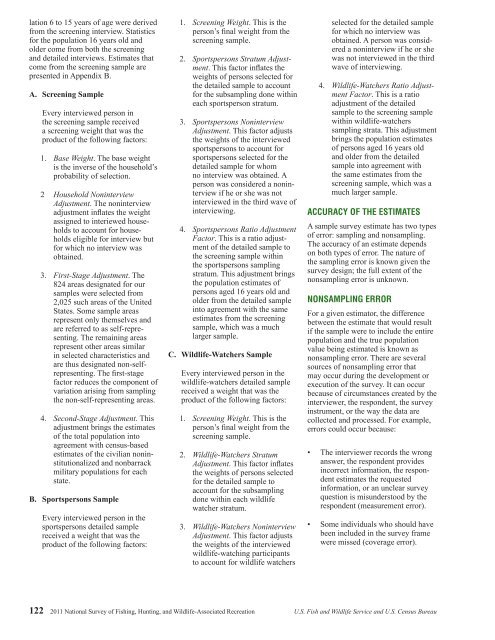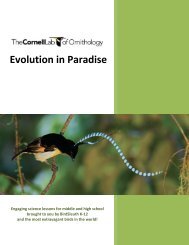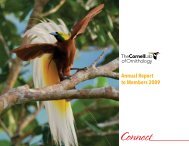lation 6 to 15 years <strong>of</strong> age were derivedfrom the screening interview. Statisticsfor the population 16 years old <strong>and</strong>older come from both the screening<strong>and</strong> detailed interviews. Estimates thatcome from the screening sample arepresented in Appendix B.A. Screening SampleEvery interviewed person inthe screening sample receiveda screening weight that was theproduct <strong>of</strong> the following factors:1. Base Weight. The base weightis the inverse <strong>of</strong> the household’sprobability <strong>of</strong> selection.2 Household NoninterviewAdjustment. The noninterviewadjustment inflates the weightassigned to interiewed householdsto account for householdseligible for interview butfor which no interview wasobtained.3. First-Stage Adjustment. The824 areas designated for oursamples were selected from2,025 such areas <strong>of</strong> the UnitedStates. Some sample areasrepresent only themselves <strong>and</strong>are referred to as self-representing.The remaining areasrepresent other areas similarin selected characteristics <strong>and</strong>are thus designated non-selfrepresenting.The first-stagefactor reduces the component <strong>of</strong>variation arising from samplingthe non-self-representing areas.4. Second-Stage Adjustment. Thisadjustment brings the estimates<strong>of</strong> the total population intoagreement with census-basedestimates <strong>of</strong> the civilian noninstitutionalized<strong>and</strong> nonbarrackmilitary populations for eachstate.B. Sportspersons SampleEvery interviewed person in thesportspersons detailed samplereceived a weight that was theproduct <strong>of</strong> the following factors:1. Screening Weight. This is theperson’s final weight from thescreening sample.2. Sportspersons Stratum Adjustment.This factor inflates theweights <strong>of</strong> persons selected forthe detailed sample to accountfor the subsampling done withineach sportsperson stratum.3. Sportspersons NoninterviewAdjustment. This factor adjuststhe weights <strong>of</strong> the interviewedsportspersons to account forsportspersons selected for thedetailed sample for whomno interview was obtained. Aperson was considered a noninterviewif he or she was notinterviewed in the third wave <strong>of</strong>interviewing.4. Sportspersons Ratio AdjustmentFactor. This is a ratio adjustment<strong>of</strong> the detailed sample tothe screening sample withinthe sportspersons samplingstratum. This adjustment bringsthe population estimates <strong>of</strong>persons aged 16 years old <strong>and</strong>older from the detailed sampleinto agreement with the sameestimates from the screeningsample, which was a muchlarger sample.C. <strong>Wildlife</strong>-Watchers SampleEvery interviewed person in thewildlife-watchers detailed samplereceived a weight that was theproduct <strong>of</strong> the following factors:1. Screening Weight. This is theperson’s final weight from thescreening sample.2. <strong>Wildlife</strong>-Watchers StratumAdjustment. This factor inflatesthe weights <strong>of</strong> persons selectedfor the detailed sample toaccount for the subsamplingdone within each wildlifewatcher stratum.3. <strong>Wildlife</strong>-Watchers NoninterviewAdjustment. This factor adjuststhe weights <strong>of</strong> the interviewedwildlife-watching participantsto account for wildlife watchersselected for the detailed samplefor which no interview wasobtained. A person was considereda noninterview if he or shewas not interviewed in the thirdwave <strong>of</strong> interviewing.4. <strong>Wildlife</strong>-Watchers Ratio AdjustmentFactor. This is a ratioadjustment <strong>of</strong> the detailedsample to the screening samplewithin wildlife-watcherssampling strata. This adjustmentbrings the population estimates<strong>of</strong> persons aged 16 years old<strong>and</strong> older from the detailedsample into agreement withthe same estimates from thescreening sample, which was amuch larger sample.ACCURACY OF THE ESTIMATESA sample survey estimate has two types<strong>of</strong> error: sampling <strong>and</strong> nonsampling.The accuracy <strong>of</strong> an estimate dependson both types <strong>of</strong> error. The nature <strong>of</strong>the sampling error is known given thesurvey design; the full extent <strong>of</strong> thenonsampling error is unknown.NONSAMPLING ERRORFor a given estimator, the differencebetween the estimate that would resultif the sample were to include the entirepopulation <strong>and</strong> the true populationvalue being estimated is known asnonsampling error. There are severalsources <strong>of</strong> nonsampling error thatmay occur during the development orexecution <strong>of</strong> the survey. It can occurbecause <strong>of</strong> circumstances created by theinterviewer, the respondent, the surveyinstrument, or the way the data arecollected <strong>and</strong> processed. For example,errors could occur because:• The interviewer records the wronganswer, the respondent providesincorrect information, the respondentestimates the requestedinformation, or an unclear surveyquestion is misunderstood by therespondent (measurement error).• Some individuals who should havebeen included in the survey framewere missed (coverage error).122 2011 <strong>National</strong> <strong>Survey</strong> <strong>of</strong> <strong>Fishing</strong>, <strong>Hunting</strong>, <strong>and</strong> <strong>Wildlife</strong>-Associated Recreation U.S. Fish <strong>and</strong> <strong>Wildlife</strong> Service <strong>and</strong> U.S. Census Bureau
• Responses are not collected fromall those in the sample or therespondent is unwilling to provideinformation (nonresponse error).• Values are estimated impreciselyfor missing data (imputation error).• Forms may be lost; data maybe incorrectly keyed, coded, orrecoded, etc. (processing error).The Census Bureau employs qualitycontrol procedures throughout theproduction process, including theoverall design <strong>of</strong> surveys, the wording<strong>of</strong> questions, the review <strong>of</strong> the work<strong>of</strong> interviewers <strong>and</strong> coders, <strong>and</strong> thestatistical review <strong>of</strong> reports to minimizethese errors. Two types <strong>of</strong> nonsamplingerror that can be examined to a limitedextent are nonresponse <strong>and</strong> undercoverage.Nonresponse. The effect <strong>of</strong> nonresponsecannot be measured directly, butone indication <strong>of</strong> its potential effect isthe nonresponse rate. For the FHWARscreener interview in the United States,the household-level nonresponse ratewas 29 percent. The person-levelnonresponse rate for the detailedsportsperson interview in the UnitedStates was an additional 31 percent<strong>and</strong> for the wildlife watchers it was33 percent. Since the screener nonresponserate is a household-level rate<strong>and</strong> the detailed interview nonresponserate is a person-level rate, we cannotcombine these rates to derive an overallnonresponse rate. Since it is unlikelythe nonresponding households to theFHWAR have the same number <strong>of</strong>persons as the households successfullyinterviewed, combining these rateswould result in an overestimate <strong>of</strong> the“true” person-level overall nonresponserate for the detailed interviews.Coverage. Overall screener undercoverageis estimated to be about 13percent. Ratio estimation to independentpopulation controls, as describedpreviously, partially corrects for thebias due to survey undercoverage.However, biases exist in the estimatesto the extent that missed persons inmissed households or missed persons ininterviewed households have differentcharacteristics from those <strong>of</strong> interviewedpersons in the same age group.Comparability <strong>of</strong> Data. Data obtainedfrom the 2011 FHWAR <strong>and</strong> othersources are not entirely comparable.This results from differences in interviewertraining <strong>and</strong> experience <strong>and</strong> indiffering survey processes. This is anexample <strong>of</strong> nonsampling variabilitynot reflected in the st<strong>and</strong>ard errors.Therefore, caution should be usedwhen comparing results from differentsources. (See Appendix C.)A Nonsampling Error Warning. Sincethe full extent <strong>of</strong> the nonsampling erroris unknown, one should be particularlycareful when interpreting results basedon small differences between estimates.The Census Bureau recommends thatdata users incorporate informationabout nonsampling errors into theiranalyses, as nonsampling error couldimpact the conclusions drawn fromthe results. Caution should also beused when interpreting results basedon a relatively small number <strong>of</strong> cases.Summary measures (such as medians<strong>and</strong> percentage distributions) probablydo not reveal useful information whencomputed on a subpopulation smallerthan 90,000 for screener data, 100,000for the detailed sportsperson data, <strong>and</strong>235,000 for the wildlife-watchers data.SAMPLING ERRORSince the FHWAR estimates comefrom a sample, they may differ fromfigures from an enumeration <strong>of</strong> theentire population using the same questionnaires,instructions, <strong>and</strong> enumerators.For a given estimator, the differencebetween an estimate based on asample <strong>and</strong> the estimate that wouldresult if the sample were to include theentire population is known as samplingerror. St<strong>and</strong>ard errors, as calculated bymethods described in “St<strong>and</strong>ard Errors<strong>and</strong> Their Use,” are primarily measures<strong>of</strong> the magnitude <strong>of</strong> sampling error.However, they may include some nonsamplingerror.St<strong>and</strong>ard Errors <strong>and</strong> Their Use. Thesample estimate <strong>and</strong> its st<strong>and</strong>ard errorenable one to construct a confidenceinterval. A confidence interval is arange that has a known probability<strong>of</strong> including the average result <strong>of</strong> allpossible samples. For example, if allpossible samples were surveyed underessentially the same general conditions<strong>and</strong> using the same sample design, <strong>and</strong>if an estimate <strong>and</strong> its st<strong>and</strong>ard errorwere calculated from each sample, thenapproximately 95 percent <strong>of</strong> the intervalsfrom 1.96 st<strong>and</strong>ard errors belowthe estimate to 1.96 st<strong>and</strong>ard errorsabove the estimate would include theaverage result <strong>of</strong> all possible samples.A particular confidence interval may ormay not contain the average estimatederived from all possible samples.However, one can say with specifiedconfidence that the interval includesthe average estimate calculated fromall possible samples. St<strong>and</strong>ard errorsmay also be used to perform hypothesistesting, a procedure for distinguishingbetween population parameters usingsample estimates. The most commontype <strong>of</strong> hypothesis is that the populationparameters are different. An examplewould be comparing the proportion <strong>of</strong>anglers to the proportion <strong>of</strong> hunters.Tests may be performed at variouslevels <strong>of</strong> significance. A significancelevel is the probability <strong>of</strong> concludingthat the characteristics are differentwhen, in fact, they are the same. Forexample, to conclude that two characteristicsare different at the 0.05 level <strong>of</strong>significance, the absolute value <strong>of</strong> theestimated difference between characteristicsmust be greater than or equalto 1.96 times the st<strong>and</strong>ard error <strong>of</strong> thedifference. This report uses 95-percentconfidence intervals <strong>and</strong> 0.05 level <strong>of</strong>significance to determine statisticalvalidity. Consult st<strong>and</strong>ard statisticaltextbooks for alternative criteria.Estimating St<strong>and</strong>ard Errors. TheCensus Bureau uses replicationmethods to estimate the st<strong>and</strong>ard errors<strong>of</strong> FHWAR estimates. These methodsprimarily measure the magnitude <strong>of</strong>sampling error. However, they domeasure some effects <strong>of</strong> nonsamplingerror as well. They do not measuresystematic biases in the data associatedwith nonsampling error. Bias isthe average over all possible samples<strong>of</strong> the differences between the sampleestimates <strong>and</strong> the true value.Generalized Variance Parameters.While it is possible to compute <strong>and</strong>present an estimate <strong>of</strong> the st<strong>and</strong>arderror based on the survey data for eachestimate in a report, there are a number<strong>of</strong> reasons why this is not done. Apresentation <strong>of</strong> the individual st<strong>and</strong>arderrors would be <strong>of</strong> limited use, sinceone could not possibly predict all <strong>of</strong>the combinations <strong>of</strong> results that maybe <strong>of</strong> interest to data users. Additionally,data users have access to FHWARmicrodata files, <strong>and</strong> it is impossible toU.S. Fish <strong>and</strong> <strong>Wildlife</strong> Service <strong>and</strong> U.S. Census Bureau 2011 <strong>National</strong> <strong>Survey</strong> <strong>of</strong> <strong>Fishing</strong>, <strong>Hunting</strong>, <strong>and</strong> <strong>Wildlife</strong>-Associated Recreation 123
- Page 1:
U.S. Fish & Wildlife Service2011Nat
- Page 4 and 5:
Economics and StatisticsAdministrat
- Page 6 and 7:
List of TablesFishing and Hunting1.
- Page 8 and 9:
ForewordWhen I was growing up, it w
- Page 11 and 12:
Highlights
- Page 13 and 14:
watching (observing, photographing,
- Page 15 and 16:
Expenditures for Wildlife-Related R
- Page 17 and 18:
Fishing
- Page 19 and 20:
Fishing ExpendituresAnglers spent $
- Page 21 and 22:
Freshwater Fishing ExpendituresAngl
- Page 23 and 24:
pike, pickerel, and muskie, as well
- Page 25 and 26:
Sex and Age of AnglersAlthough more
- Page 27 and 28:
The majority of anglers had househo
- Page 29:
2001-2011 Fishing Participants, Day
- Page 32 and 33:
Hunting HighlightsIn 2011, 13.7 mil
- Page 34 and 35:
Big Game HuntingIn 2011, a majority
- Page 36 and 37:
Days per hunterTrips per hunterTrip
- Page 38 and 39:
Hunting on Public and PrivateLandsm
- Page 40 and 41:
Large MSA25%Medium MSA17%Percent of
- Page 42 and 43:
Hispanics, who represent a growingp
- Page 45 and 46:
Wildlife WatchingU.S. Fish and Wild
- Page 47 and 48:
Wildlife-Watching ExpendituresThirt
- Page 49 and 50:
Wildlife Fed, Observed, orPhotograp
- Page 51 and 52:
Metropolitan and NonmetropolitanAro
- Page 53 and 54:
Education, Race, and Ethnicity ofAr
- Page 55 and 56:
Away-From-Home Participantsby Type
- Page 57 and 58:
Away-From-Home WildlifeWatchers by
- Page 59 and 60:
Metropolitan and NonmetropolitanAwa
- Page 61 and 62:
2001-2011 Comparison of Wildlife-Wa
- Page 63:
2006-2011 Wildlife-Watching Partici
- Page 66 and 67:
Guide to Statistical TablesPurpose
- Page 68 and 69:
Table 3. Freshwater Anglers and Day
- Page 70 and 71:
Table 7. Hunters and Days of Huntin
- Page 72 and 73:
Table 8. Selected Characteristics o
- Page 74 and 75:
Table 9. Selected Characteristics o
- Page 76 and 77:
Table 10. Selected Characteristics
- Page 78 and 79:
Table 12. Expenditures for Fishing:
- Page 80 and 81:
Table 14. Trip and Equipment Expend
- Page 82 and 83: Table 16. Trip and Equipment Expend
- Page 84 and 85: Table 18. Trip and Equipment Expend
- Page 86 and 87: Table 20. Trip and Equipment Expend
- Page 88 and 89: Table 22. Special Equipment Expendi
- Page 90 and 91: Table 25. Freshwater Anglers and Da
- Page 92 and 93: Table 29. Hunters and Days of Hunti
- Page 94 and 95: Table 33. Hunters Preparing for Hun
- Page 96 and 97: Table 37. Participation in Wildlife
- Page 98 and 99: Table 40. Expenditures for Wildlife
- Page 100 and 101: Table 41. Selected Characteristics
- Page 102 and 103: Table 42. Selected Characteristics
- Page 104 and 105: Table 46. Total Wildlife-Related Pa
- Page 106 and 107: Appendix A.DefinitionsAnnual househ
- Page 108 and 109: State governments (such as State pa
- Page 110 and 111: Appendix B.2010 Participation of 6-
- Page 112 and 113: Table B-4. Most Recent Year of Fish
- Page 114 and 115: Table B-7. Selected Characteristics
- Page 116 and 117: Table B-9. Participation by 6-to-15
- Page 118 and 119: Appendix C.Significant Methodologic
- Page 120 and 121: Table C-1. Major Characteristics of
- Page 122 and 123: Table C-2. Anglers and Hunters by C
- Page 124 and 125: household income in the 2001Survey.
- Page 126 and 127: Table C-4. Comparison of Major Find
- Page 128 and 129: Table C-5. Anglers and Hunters by C
- Page 130 and 131: Appendix D.Sample Design and Statis
- Page 134 and 135: compute in advance the standard err
- Page 136 and 137: Illustration of the Computation of
- Page 138 and 139: Table D-2. Approximate Standard Err
- Page 140 and 141: Table D-4. Approximate Standard Err
- Page 143: U.S. Department of the InteriorU.S.






